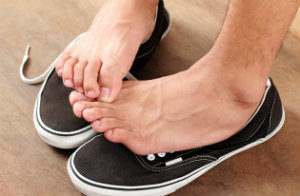


It’s the scourge of locker rooms far and wide; perhaps even more so than a rogue towel-snapper. You don’t see it coming until you get it, and by then the itching and burning becomes nearly all you can think about! It’s athlete’s foot, and you don’t have to be a sporting guru to pick up this stubborn infection. Your feet just have to be in the wrong place at the wrong time.
 A Fungal Invasion
A Fungal InvasionThis itchy rash on the feet is caused by a form of fungus that has never been humanity’s best friend. It’s the same fungus that can cause jock itch or ringworm as well. Once it invades the top layer of skin, it begins to flourish and cause trouble.
The infection can show itself in a few different ways. It can appear between the webbing of the toes (usually between the fourth and fifth), causing the skin to become scaly and cracked. It can also begin on the heel or bottom of the foot, causing the skin to become thick and cracked (known as a moccasin infection). A third form begins with fluid-filled blisters developing just beneath the skin, usually on the bottom of the foot.
The athlete’s foot fungus thrives best in damp, dark, and warm environments. These conditions are what makes locker rooms, public pools, and similar areas a particular risk for picking it up. Once it is on your foot, sweaty socks and shoes can provide a prime environment for the fungus to continue growing. The fungus can also be transferred from person to person through direct contact.
One of the main goals in treating this condition is to prevent the infection from spreading to other parts of the body. The fungus is also capable of infecting the hands and groin, often traveling through direct touch or on towels. It is important to keep these factors in mind and take measures to avoid unnecessary spread of the infection.
Mild cases of athlete’s foot can often be treated with over-the-counter sprays, ointments, or lotions. These can take 1-6 weeks to fully work. If there’s no improvement, then it’s time to see a professional for more advanced options. If you have diabetes, it’s also very important to seek expert care to avoid the potential of deeper problems or complications.
A prescription for a stronger medication may be needed for more severe forms of this condition. In some cases, oral antifungal medications might be necessary. Options will depend on a thorough examination of the infection and the health of the patient.
The best remedy, of course, is preventing it from happening in the first place. Reduce your risk by keeping your feet dry as often as possible, wearing light, ventilated shoes, and using shower shoes in damp community areas to protect yourself.
If you need help with a stubborn case of athlete’s foot, Dr. Kevin Powers is here to serve patients in Bloomington, Bedford, and surrounding areas. Call us at (812) 333-4422 or use our online contact form to get in touch with us today.